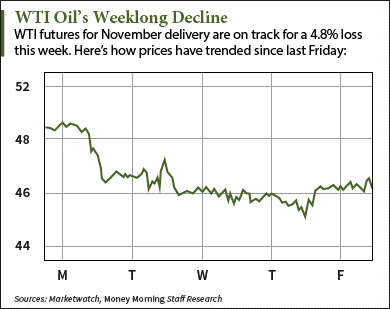WTI crude oil prices today (Friday) fell 0.3% after a report from the U.S. Energy Information Administration (EIA) showed oil supplies keep climbing.
(Friday) fell 0.3% after a report from the U.S. Energy Information Administration (EIA) showed oil supplies keep climbing.
At 10:25 a.m., WTI crude oil prices today were trading at $46.25 a barrel. Yesterday, the U.S. benchmark closed at $46.38, its lowest settlement since Oct. 5. Futures are down 6.8% since last Friday but up 2.6% so far in October.
Meanwhile, Brent crude oil prices tumbled 0.6% to $49.42 a barrel today. The international benchmark is down 6.6% this week but up 0.8% this month.
The continuing decline in WTI crude oil prices today came following the EIA's latest supply numbers. Yesterday, the agency reported U.S. oil inventories grew by 7.6 million barrels last week. Total U.S. supply remains near an 80-year high of 468.6 million barrels.
Oil's weekly decline also comes on news of a potential meeting between Russia and OPEC at the end of the month. Russia and Saudi Arabia announced they're ready to discuss low oil prices since both economies desperately rely on export revenue.
"I don't think anything will ever come of that, but just the fact that they're meeting makes people nervous a little bit," said Bob Yawger, futures director at Mizuho Securities USA, to The Wall Street Journal. "The market is very sensitive to any issue dealing with production."
According to Money Morning Global Energy Strategist Dr. Kent Moors, this is a critical development for the energy industry.
Because if OPEC and Russia don't solve the oil crisis, many global economies could collapse...
Will an OPEC and Russia Meeting Boost WTI Crude Oil Prices?
Russia could boost WTI crude oil prices by convincing Saudi Arabia to reduce its short-term production.
[mmpazkzone name="in-story" network="9794" site="307044" id="137008" type="4"]
You see, overproduction has been a huge problem for OPEC this year. On Oct. 12, the cartel reported it produced 31.6 million barrels a day in September. That's well above the proposed cap of 30 million barrels a day. It was also the highest monthly output in over three years.
Since other cartel members are flooding the market with oil, the Saudis are increasing output to maintain their revenue share.
"The convoluted rationale behind this tactic has strained credibility, but the real reason is simple: The Saudis cannot prevent other OPEC nations from raising volume in a desperate attempt to collect revenue," Moors said. "So they need to appear to be leading the effort."
At the meeting, Russia could persuade Saudi Arabia to lower production while Russia boosts production. Saudi Arabia cutting production would ease the tensions of the other suffering OPEC member countries, like Libya and Venezuela, which are readying for a political revolt. It would also demonstrate Saudi Arabia's efforts to improve oil prices and show its leadership abilities to other members.
Most importantly, the reduced output from OPEC's largest producer would ease the glut and cause prices to bottom out. From there, they can begin their long-term rebound as demand increases into 2016.
"The stage now seems set for a Russian-Saudi meeting to precede a broader OPEC session," Moors said. "That should be enough for crude prices to find a floor and improve."
Alex McGuire is an associate editor for Money Morning who writes about energy. Follow him on Twitter for all of the biggest oil and gas updates.
How Does U.S. Oil Consumption Compare to Other Countries? In 2014, there were 92.1 million barrels of oil consumed around the world every single day. But how much oil did the U.S. use every day? This chart shows how the U.S. stacked up against other big time oil consumers in 2014...


